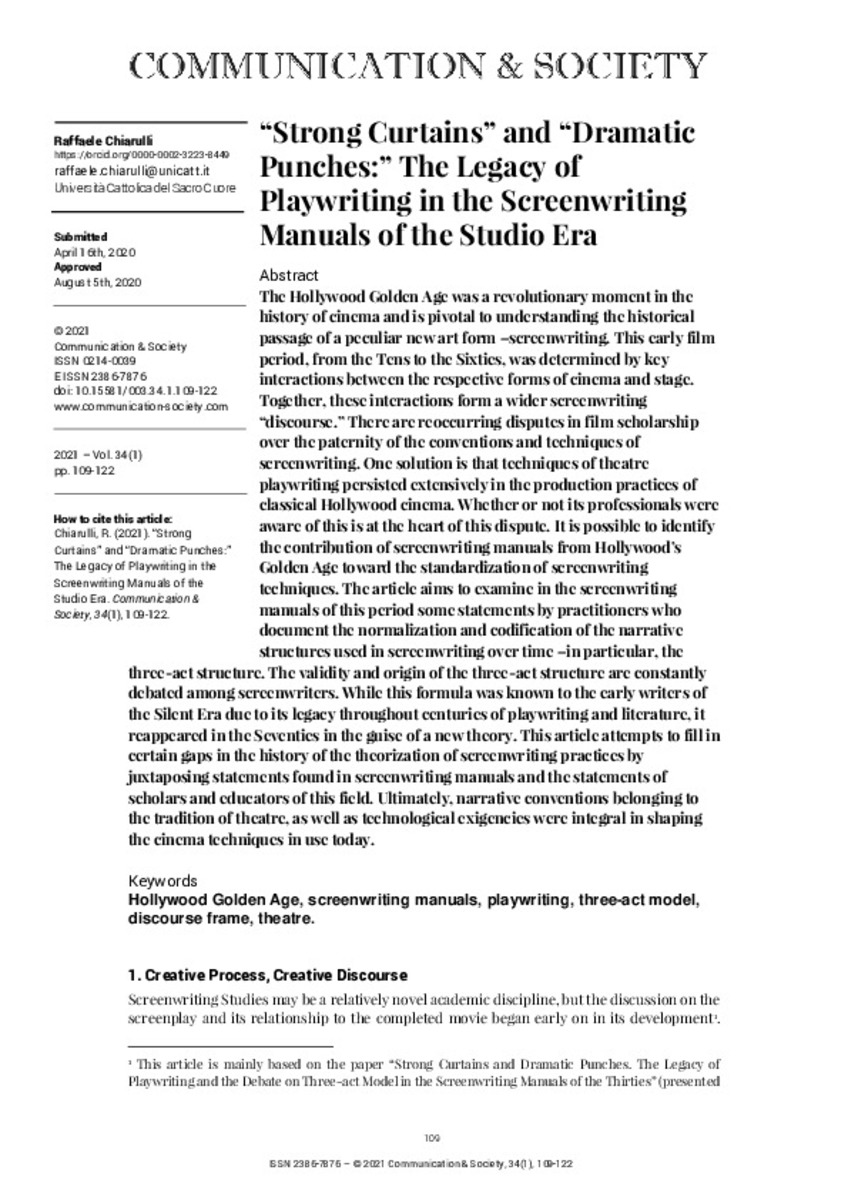Full metadata record
| DC Field | Value | Language |
|---|---|---|
| dc.creator | Chiarulli, R. (Raffaele) | - |
| dc.date.accessioned | 2021-01-12 | - |
| dc.date.accessioned | 2021-01-13T08:42:36Z | - |
| dc.date.available | 2021-01-13T08:42:36Z | - |
| dc.date.issued | 2021 | - |
| dc.identifier.citation | Chiarulli, R. (Raffaele). "«Strong Curtains» and «Dramatic Punches»: The Legacy of Playwriting in the Screenwriting Manuals of the Studio Era". Communication & Society. 34 (1), 2021, 109 - 122 | es |
| dc.identifier.issn | 2386-7876 | - |
| dc.identifier.uri | https://hdl.handle.net/10171/59966 | - |
| dc.description.abstract | The Hollywood Golden Age was a revolutionary moment in the history of cinema and is pivotal to understanding the historical passage of a peculiar new art form –screenwriting. This early film period, from the Tens to the Sixties, was determined by key interactions between the respective forms of cinema and stage. Together, these interactions form a wider screenwriting “discourse.” There are reoccurring disputes in film scholarship over the paternity of the conventions and techniques of screenwriting. One solution is that techniques of theatre playwriting persisted extensively in the production practices of classical Hollywood cinema. Whether or not its professionals were aware of this is at the heart of this dispute. It is possible to identify the contribution of screenwriting manuals from Hollywood’s Golden Age toward the standardization of screenwriting techniques. The article aims to examine in the screenwriting manuals of this period some statements by practitioners who document the normalization and codification of the narrative structures used in screenwriting over time –in particular, the three-act structure. The validity and origin of the three-act structure are constantly debated among screenwriters. While this formula was known to the early writers of the Silent Era due to its legacy throughout centuries of playwriting and literature, it reappeared in the Seventies in the guise of a new theory. This article attempts to fill in certain gaps in the history of the theorization of screenwriting practices by juxtaposing statements found in screenwriting manuals and the statements of scholars and educators of this field. Ultimately, narrative conventions belonging to the tradition of theatre, as well as technological exigencies were integral in shaping the cinema techniques in use today. | en_US |
| dc.language.iso | eng | - |
| dc.publisher | Servicio de Publicaciones de la Universidad de Navarra | es_ES |
| dc.rights | info:eu-repo/semantics/openAccess | es_ES |
| dc.title | «Strong Curtains» and «Dramatic Punches»: The Legacy of Playwriting in the Screenwriting Manuals of the Studio Era | en_US |
| dc.type | info:eu-repo/semantics/article | es_ES |
| dc.identifier.doi | 10.15581/003.34.1.109-122 | - |
| dadun.citation.endingPage | 122 | - |
| dadun.citation.number | 1 | - |
| dadun.citation.publicationName | Communication & Society | - |
| dadun.citation.startingPage | 109 | - |
| dadun.citation.volume | 34 | - |
Files in This Item:
Statistics and impact
Items in Dadun are protected by copyright, with all rights reserved, unless otherwise indicated.






